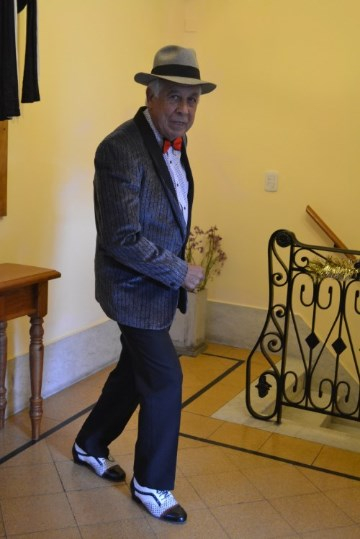If you are a tango dancer, you should try at least once to dance canyengue. If you don’t know much about this style, Nelson, visiting canyengue teacher form Buenos Aires, is talking about this beautiful dance in an interview for Tango Synergy. Enjoy!
Interview with Nelson, by Mona
Tell me about Canyengue, where would you place this style of dance in the history of tango.
The music came before the dance. In the late 1800s early 1900s the musicians started to write the music. Prior to this they played by ear. Music always written in 4×2 but then, in 1925-30 it changed to 2×4. Lyrics were first recorded in 1895 by Flora Rodriguez De Gotti. Edwardo Aroles was a principal pioneer of the early tango music. Other notable musicians of the time were Rosendo Mendizabal, Nava Arturo, Alfred Eusebid Gobbi, and Enrique Saborido. Alfred Eusebid Gobbi gave the first tango class in Paris in 1901.
Canyengue music had many outside influences such as English country dance music, the mazurka and polkas from Poland and the Habeneras from Cuba.The River Plate area influenced the milonga music taking from their country music prior to 1880. The choreography of the dance was created mainly by the slaves, which was then adopted by the Creoles.
When did you start dancing and what kept you in the beautiful world of tango?
I started tango as a boy in Uruguay. Tango music was all around me and. So it was inevitable that I would be attracted to the music and the dance.
What made you start teaching Canyengue? What is your greatest joy when you teach?
I started Teaching Canyengue when I moved to Buenos Aires in 2011 because I wished to impart the history of the tango. Canyengue to me is the identity of the tango. I have also been assisting Manolo and Marta Anton, the principal Canyengue teachers in BA with their classes. I have also worked with Laura Collavani. Some of the venues that I have worked in are The Argentinian Academie, BA Academie and Yuri Yuri Academie in San Telmo. My greatest joy is transmitting the concept and history of Canyengue to my students in BA and in Australia.
 How popular is this dance and what is special about its music?
How popular is this dance and what is special about its music?
Canyengue, like Tango, is danced all around the world. There is a lot of interest especially Europe and Asia and North America. In BA at this time Canyengue has a small following but interest is growing. Each year there is a Canyengue Festival and there are regular Canyengue milongas.
How important is for a tango dancer to know how to dance canyengue?
In my opinion it is essential to learn Canyengue as a base to learning other styles of tango. Canyengue teaches the rhythm, musicality and makes the next step into other styles an easy transition.
What brings back to Sydney every year? It’s the weather, it’s the welcoming community?
I emigrated to Sydney in 1974 and settled in the southern districts. After a while, I decided to return to South America to be close to the city where I grew up. I dreamed of indulging my passion for tango and in particular Canyengue and now it is a very big part of my life in BA. I return every year to visit family and friends and while in Sydney I hold workshops with the help of Tango Synergy to keep the interest in Canyengue going. I also catch up with many “old” tango friends who, like myself, were part of the very early tango scene in Sydney. I am delighted to see in Canberra that Ann and Myk are starting up classes. I am hoping that this will see an increase in numbers learning Canyengue around Australia. Ann and Myk spent time in BA and took classes from Manolo and myself whilst there with the idea to return to Canberra and create an interest in Canyengue. Alberto and Natalia, a couple in Melbourne have taught for many years and in Perth. There is a class In Alice Springs run by Gaston Valdes and In Queensland Luis Gomez runs a class. So, you see, as long as these classes survive the old style tango and its beautiful music will survive. It makes me very happy to know that the Canyengue music and dance is enjoyed by a group of dancers in Australia. It may be small now, but it will grow over the years.

